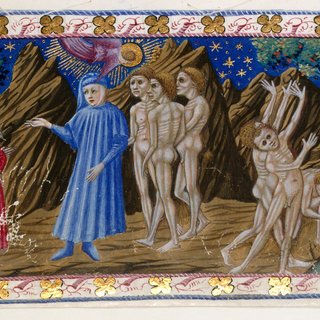Retaining Context and Form Despite Linguistic Differences
Exploring Translations of Dante's Purgatorio Canto XXIII
Dante Alighieri’s Divine Comedy is a famous work of art that has fascinated readers throughout the ages. This epic poem is renowned for its visceral and powerful depiction of the Christian afterlife, and its controversial callouts of numerous religious and political figures. Unfortunately for English readers around the globe, its true magnificence cannot be experienced. The problem with Dante’s works lies in the fact that English is a horrible language to translate 14th-century Italian into. Many poets and translators have tried, but most translations end up losing some of the original context or poetic form. This book explores three different translations of Dante’s Purgatorio, Canto XXIII, in which the protagonist Dante is partway through the sixth level of Purgatory. All of them are great examples of how translators tried to balance the context, form, and structure of the epic poem.
The version of Purgatorio Canto XXIII that is displayed is Henry Longfellow’s 1867 poetic translation, which is considered to be one of the best at preserving Dante’s poetic form and context, even if the language sounds overly dramatic and obscure in the modern era. The other two translations, written by John Ciardi and Mary Jo Bang, are compared and discussed in the annotations. John Ciardi’s 1957 poetic translation is similar to Longfellow’s, but he sometimes sacrifices the poem’s original structure to clarify a topic or line in a way that still sounds poetic. Mary Jo Bang’s 2021 prose translation has received criticism for deviating from the original poetic form, but her adjustments to each individual passage add blunt clarity for a reader who is unfamiliar with Italian, Latin, and older forms of English.

"Dante Illuminating Florence with his Poem," by Domenico di Michelino, 1465

Recent Activity
Resource Added Resource Added Acrodermatitis Hand
Text Added A Note On Languages
Text Added Annotated Bibliography
Resource Added Dante Lab at Dartmouth College: Reader
Resource Added Dante Illuminating Florence with his Poem
Texts
Foreword
- This text has 0 annotations
- This text has 0 highlights
Translation and Annotations
- This text has 7 annotations
- This text has 0 highlights
Uncategorized
- This text has 0 annotations
- This text has 0 highlights
Resources
Single Resources
Image Leprosy thigh demarcated cutaneous lesions
Image Acrodermatitis Hand
Link Dante Lab at Dartmouth College: Reader
Image Dante Illuminating Florence with his Poem
Image Priamo dell quercia, purgatorio 09 golosi.jpg
Link "The Divine Comedy" translated by John Ciardi
Link "Purgatorio" translated by Mary Jo Bang
Link “How to Read Dante in the 21st Century.” by Joseph Luzzi
Link “What's the Best Way to Read the Divine Comedy If You Don't Know Italian?” by Meredith Hindley et al.
Metadata
- publisher placeSeattle, WA
- rightsCC By NC
- rights holderUniversity of Washington Libraries

